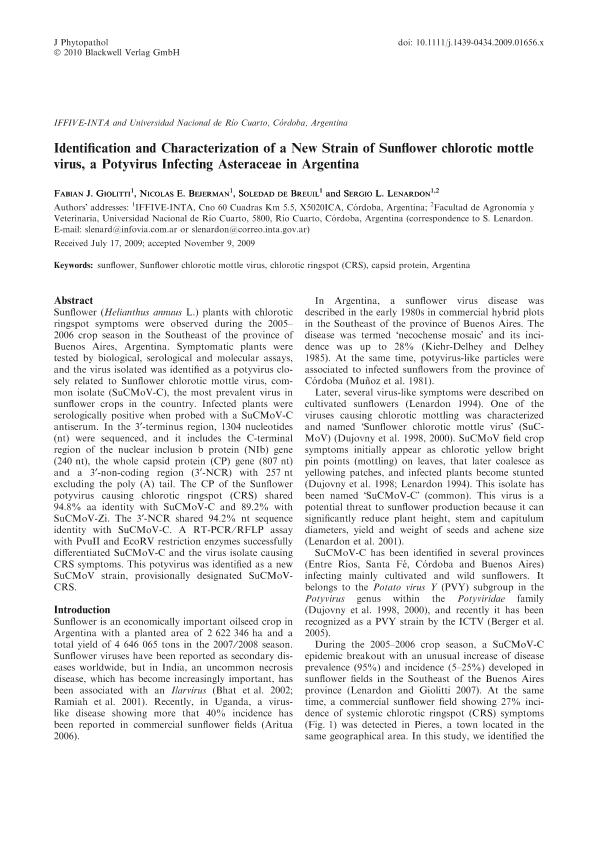Mostrar el registro sencillo del ítem
dc.contributor.author
Giolitti, Fabián José

dc.contributor.author
Bejerman, Nicolas

dc.contributor.author
de Breuil, Soledad

dc.contributor.author
Lenardon, Sergio Luis

dc.date.available
2023-02-17T18:24:06Z
dc.date.issued
2010-08
dc.identifier.citation
Giolitti, Fabián José; Bejerman, Nicolas; de Breuil, Soledad; Lenardon, Sergio Luis; Identification and characterization of a new strain of sunflower chlorotic mottle virus, a potyvirus infecting asteraceae in Argentina; Wiley Blackwell Publishing, Inc; Journal of Phytopathology-Phytopathologische Zeitschrift; 158; 7-8; 8-2010; 536-541
dc.identifier.issn
0931-1785
dc.identifier.uri
http://hdl.handle.net/11336/188449
dc.description.abstract
Sunflower (Helianthus annuus L.) plants with chlorotic ringspot symptoms were observed during the 2005– 2006 crop season in the Southeast of the province of Buenos Aires, Argentina. Symptomatic plants were tested by biological, serological and molecular assays, and the virus isolated was identified as a potyvirus closely related to Sunflower chlorotic mottle virus, common isolate (SuCMoV-C), the most prevalent virus in sunflower crops in the country. Infected plants were serologically positive when probed with a SuCMoV-C antiserum. In the 3¢-terminus region, 1304 nucleotides (nt) were sequenced, and it includes the C-terminal region of the nuclear inclusion b protein (NIb) gene (240 nt), the whole capsid protein (CP) gene (807 nt) and a 3¢-non-coding region (3¢-NCR) with 257 nt excluding the poly (A) tail. The CP of the Sunflower potyvirus causing chlorotic ringspot (CRS) shared 94.8% aa identity with SuCMoV-C and 89.2% with SuCMoV-Zi. The 3¢-NCR shared 94.2% nt sequence identity with SuCMoV-C. A RT-PCR ⁄ RFLP assay with PvuII and EcoRV restriction enzymes successfully differentiated SuCMoV-C and the virus isolate causing CRS symptoms. This potyvirus was identified as a new SuCMoV strain, provisionally designated SuCMoVCRS.
dc.format
application/pdf
dc.language.iso
eng
dc.publisher
Wiley Blackwell Publishing, Inc

dc.rights
info:eu-repo/semantics/openAccess
dc.rights.uri
https://creativecommons.org/licenses/by-nc-sa/2.5/ar/
dc.subject
ARGENTINA
dc.subject
CAPSID PROTEIN
dc.subject
CHLOROTIC RINGSPOT (CRS)
dc.subject
SUNFLOWER
dc.subject
SUNFLOWER CHLOROTIC MOTTLE VIRUS
dc.subject.classification
Virología

dc.subject.classification
Ciencias Biológicas

dc.subject.classification
CIENCIAS NATURALES Y EXACTAS

dc.title
Identification and characterization of a new strain of sunflower chlorotic mottle virus, a potyvirus infecting asteraceae in Argentina
dc.type
info:eu-repo/semantics/article
dc.type
info:ar-repo/semantics/artículo
dc.type
info:eu-repo/semantics/publishedVersion
dc.date.updated
2023-02-07T11:52:21Z
dc.identifier.eissn
1439-0434
dc.journal.volume
158
dc.journal.number
7-8
dc.journal.pagination
536-541
dc.journal.pais
Reino Unido

dc.journal.ciudad
Londres
dc.description.fil
Fil: Giolitti, Fabián José. Instituto Nacional de Tecnología Agropecuaria. Centro de Investigación en Ciencias Veterinarias y Agronómicas. Instituto de Fitopatología y Fisiología Vegetal; Argentina
dc.description.fil
Fil: Bejerman, Nicolas. Instituto Nacional de Tecnología Agropecuaria. Centro de Investigaciones Agropecuarias. Unidad de Fitopatología y Modelización Agrícola - Consejo Nacional de Investigaciones Científicas y Técnicas. Centro Científico Tecnológico Conicet - Córdoba. Unidad de Fitopatología y Modelización Agrícola; Argentina
dc.description.fil
Fil: de Breuil, Soledad. Instituto Nacional de Tecnología Agropecuaria. Centro de Investigaciones Agropecuarias. Unidad de Fitopatología y Modelización Agrícola - Consejo Nacional de Investigaciones Científicas y Técnicas. Centro Científico Tecnológico Conicet - Córdoba. Unidad de Fitopatología y Modelización Agrícola; Argentina
dc.description.fil
Fil: Lenardon, Sergio Luis. Instituto Nacional de Tecnología Agropecuaria. Centro de Investigación en Ciencias Veterinarias y Agronómicas. Instituto de Fitopatología y Fisiología Vegetal; Argentina. Universidad Nacional de Río Cuarto. Facultad de Agronomía y Veterinaria; Argentina
dc.journal.title
Journal of Phytopathology-Phytopathologische Zeitschrift

dc.relation.alternativeid
info:eu-repo/semantics/altIdentifier/url/https://onlinelibrary.wiley.com/doi/full/10.1111/j.1439-0434.2009.01656.x
dc.relation.alternativeid
info:eu-repo/semantics/altIdentifier/doi/https://doi.org/10.1111/j.1439-0434.2009.01656.x
Archivos asociados
